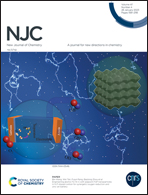Experimental study of an amphiphilic graphene oxide based nanofluid for chemical enhanced oil recovery of heavy oil
Abstract
Nanofluids have great potential in enhanced oil recovery due to their small scale and interface effect, but their displacement mechanism is still unclear. In order to further study the oil displacement mechanism and oil displacement efficiency of nanofluids, graphene oxide (GO) covalently combined with polyethylene glycol brush (called GOC) was used as the raw material to develop a highly active nanofluid. By means of static macro–meso–microscopic experiments and core physical simulation, the ability of the nanofluid to reduce interfacial tension is evaluated, the mechanism of fluidity control is clarified, and the mesoscopic oil displacement efficiency is quantified. The experimental results show that the GOC nanofluid can improve the wettability of rocks from the oil-wet to water-wet, making oil droplets easier to peel and can reduce the interfacial tension of ordinary heavy oil to 10−2 mN m−1. When the water cut in reservoirs is 30–80%, the viscosity of the oil–water emulsion with high activity nanofluid intervention is 1.28–4.32 times that of crude oil, showing good in situ mobility control performance. The highly active nanofluid has a strong adaptability to core permeability. Water is injected into the core 98% water content, 0.02 wt% highly active nanofluid 0.6 times pore volume is controlled by in situ fluidity, which significantly improves the recovery by more than 25%. The research results deepen the mechanism of nanofluid flooding and provide a new path for chemical flooding to enhance oil recovery.



 Please wait while we load your content...
Please wait while we load your content...